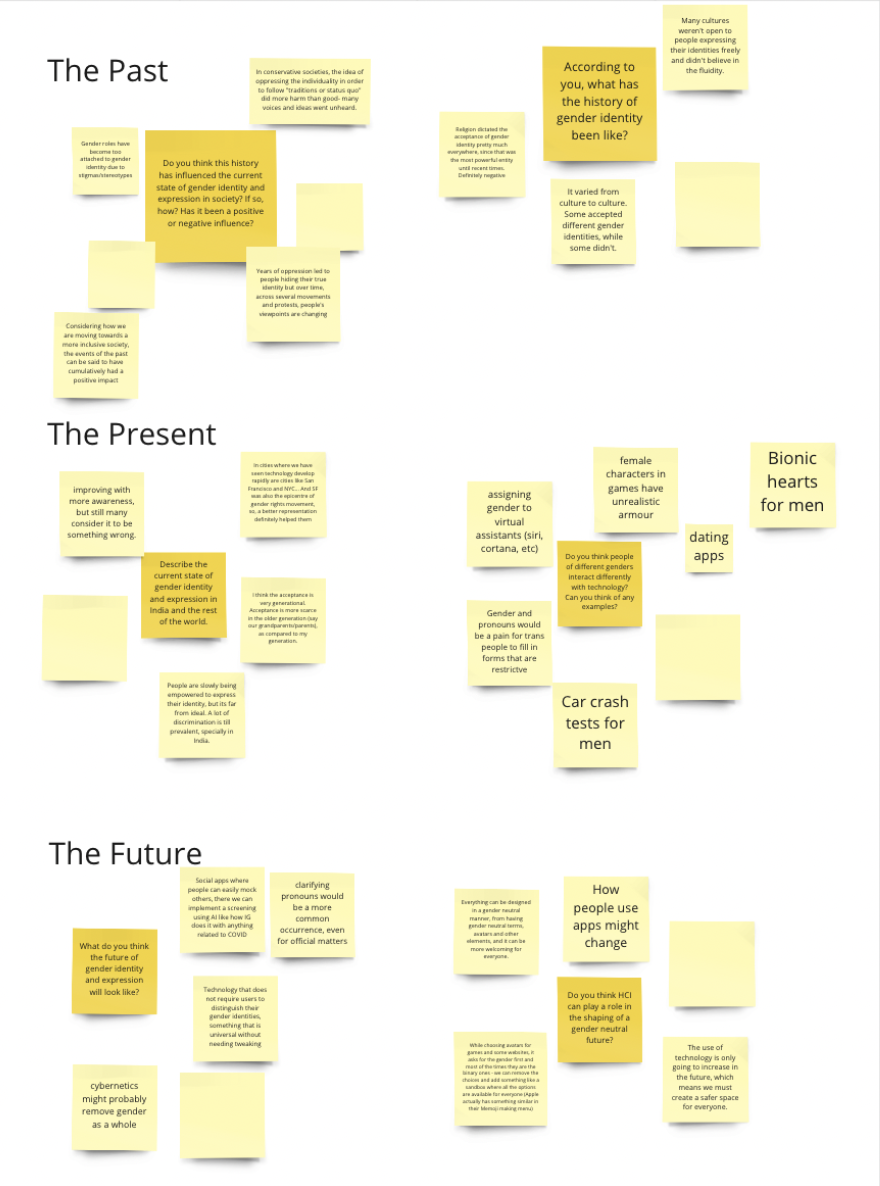GenVoid | Speculative Design |
GenVoid | Speculative Design |
Aim: GenVoid is a critical exploration of gender neutrality using Speculative Design techniques such as props, world building, and participatory workshops.
Process: Literature review, Participatory Workshop, World Building
Team: Riya Sogani, Sushmita Vavilala, Arshad Abbas, Apeksha Maithani, Ananya Singh, and Dr. Grace Eden.
Team: Riya Sogani, Sushmita Vavilala, Arshad Abbas, Apeksha Maithani, Ananya Singh, and Dr. Grace Eden.
Outcome: Published as a poster in RIISE ‘22. Can be accessed here.
[duh·zine fik·shn] (noun)
Design fiction is a design practice aiming at exploring and criticising possible futures by creating speculative, and often provocative, scenarios narrated through designed artifacts.
Defining the Domain
Gender neutrality is the idea that policies, language, and other social institutions should avoid distinguishing roles according to people's sex or gender.
Our literature review showed us great scope of HCI to be involved in a potential future of gender neutrality, especially considering the bias some genders face in technological domains in the present day. We also judged the potential impacts of gender neutrality in social, economic, and political domains, and decided it was something we would be interested in exploring further.
Process
Participatory Workshop 1
The primary aim of this workshop is to understand how our participants imagine a gender-neutral world.
World Building
Based on ideas from our participants, we build a gender neutral-world by designing props and creating a video prototype.
Participatory Workshop 2
The primary aim of this workshop is to test our video prototype and generate discussion around the nuances of the gender-neutral world.
Workshop 1
Methodology:
10 participants
Ages 18-55
3 activities - Mapping the Futures, Future Cone Thing from the Future.
Mapping the Future:
The aim of this activity was to help our participants gather their understanding of the history and past trends in gender presentation so that they are able to understand the effects of this on gender identity in the present day, and also use this insight to ideate potential outcomes of the future. To do this, we present our participants with questions regarding the past, present, and future of gender identity, and allow them to brainstorm and discuss their answers to these questions in a focus group format.
Thing from the Future
We then presented our participants with ‘Thing from the Future’ cards to help them ideate artifacts that could potentially exist in the future worlds they hypothesized in the previous exercise. The participants were split into 2 smaller focus groups of 5 participants each, and each group was randomly assigned certain acts, terrains, objects, and moods. Participants were required to use these prompts to ideate artifacts, present these artifacts to the other group and offer mutual feedback.
Futures Cone
The aim of this activity was to help our participants ideate potential future scenarios that could result based on current day trends. We asked them to brainstorm their ideas and then categorize them as projected, probable, plausible, possible, and preposterous, based on the futures cone.
Analysis and Discussion
We then analysed the results of the workshop using affinity mapping to identify positive trends, negative trends, and alternate futures associated with gender-neutrality.
It was very interesting to see how each and every participant approached the topic of gender neutrality from a different and unique perspective. They all had different ideas for how gender could be concealed, and what the world would be like if it was. We discussed the future of gender neutrality in a wide variety of domains such as video games, families, and sports.
One thing that they all agreed upon was that gender neutrality would lead to a positive future, with a safer and less biased environment for all genders. However, they also brought to light some dystopian scenarios which could arise as a result of over-regulation of gender-neutrality.
World Building
Gen R App
Aim: Ensure that gender neutral language is enforced (so that people don’t go back to the gender binary)
Based on the insight given by our participants in the participatory design workshop, we designed the following artifacts to exist in a gender-neutral world. We also made a video prototype displaying how these artifacts would be used.
Gen Robes
Aim: Conceal the sex of children so that there is no bias about their gender
The ‘Neutrality Act of the Future’
Aim: Add an authoritarian, almost dystopian aspect to the future.
'Behind the Clothes' Exhibit
Aim: Educate children about gender and sex (history, present)
Workshop 2
Methodology
For our second workshop, we explained to the participants each of the props, showed them the diegetic prototype, role-played in a Q&A session with a 'human from the future', and then gave them prompts for them to offer their thoughts.
Discussion
Participants understood the relevance of the props in a gender-neutral world. They reflected on their own gendered biases, which sparked a critical dialogue regarding the impact of gender in current socioeconomic situations, and the potential risks and benefits associated with a future of gender neutrality.









